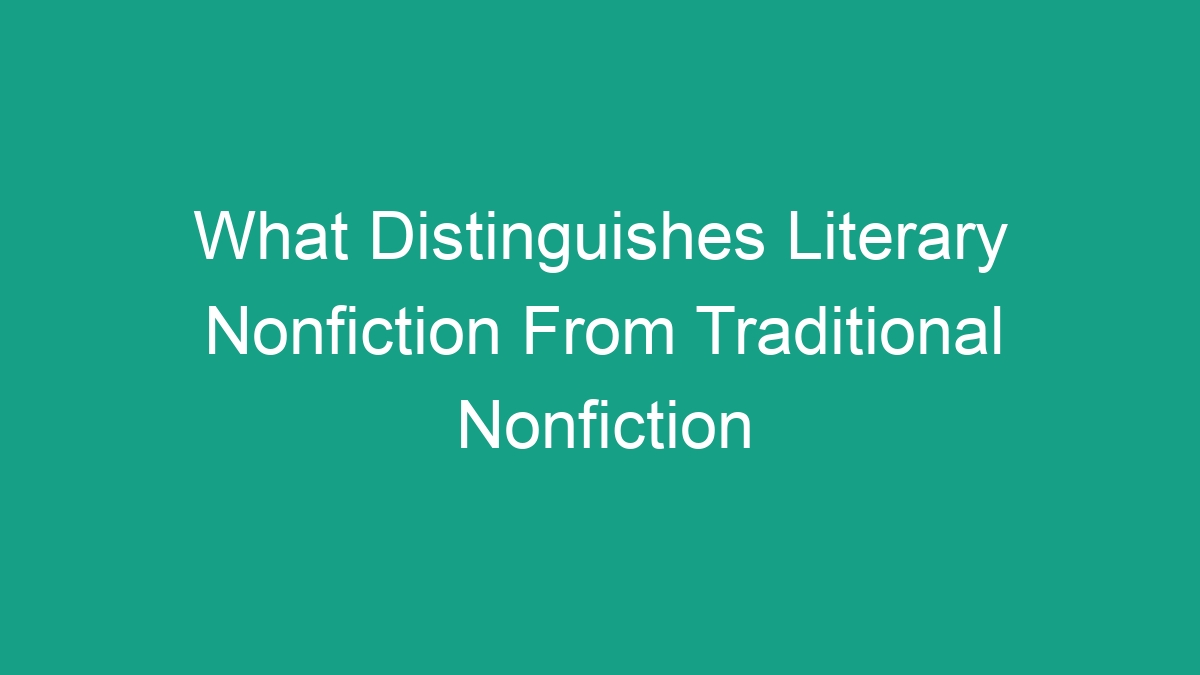
Introduction
When it comes to nonfiction writing, there are various styles and genres that authors can choose from. Two popular types of nonfiction are traditional nonfiction and literary nonfiction. While both share the characteristic of being based on real events and facts, there are key differences that set them apart. In this article, we will explore what distinguishes literary nonfiction from traditional nonfiction, and the unique qualities that make each style stand out.
Defining Traditional Nonfiction
Traditional nonfiction, also known as factual nonfiction, encompasses a wide range of genres, including textbooks, biographies, self-help books, and journalistic articles. This form of nonfiction is rooted in presenting information and facts in a straightforward and objective manner. The primary goal of traditional nonfiction is to inform and educate the reader on a particular subject matter, without the use of embellishments or creative storytelling techniques.
When it comes to traditional nonfiction, the author’s voice typically takes a backseat to the subject matter being presented. The writing is focused on delivering comprehensive and accurate information in a clear and concise manner. Examples of traditional nonfiction works include scientific research papers, historical accounts, and instructional manuals.
Understanding Literary Nonfiction
Literary nonfiction, on the other hand, delves into the realm of creative and artistic expression while still maintaining its foundation in real-life events and facts. This genre is often characterized by its use of literary devices such as imagery, symbolism, and narrative storytelling to convey its message. Literary nonfiction is not just about presenting facts; it aims to engage the reader on an emotional and intellectual level, often blurring the lines between fiction and reality.
One of the key distinguishing features of literary nonfiction is the author’s voice and personal perspective. Authors of literary nonfiction often interject their own experiences, opinions, and reflections into the narrative, allowing for a more subjective and personal connection with the reader. This personal touch adds a layer of depth and complexity to the storytelling, making it more immersive and impactful.
The Role of Creativity
In traditional nonfiction, the focus is on adhering to established facts and evidence, leaving little room for creative interpretation. In literary nonfiction, however, authors have the freedom to approach their subject matter with a creative lens, employing techniques commonly found in fiction writing, such as character development, setting descriptions, and thematic exploration. This creative approach allows for a more compelling and emotionally resonant narrative that goes beyond simply presenting information.
Furthermore, literary nonfiction often blurs the boundaries between genres, incorporating elements of memoir, travel writing, and personal essay into its storytelling. This interplay of different literary forms adds depth and richness to the narrative, offering a multi-dimensional perspective on the subject matter.
Emotional and Intellectual Engagement
Another distinguishing factor between literary nonfiction and traditional nonfiction is the level of emotional and intellectual engagement it offers to the reader. While traditional nonfiction aims to inform and educate, literary nonfiction seeks to evoke a deeper emotional and intellectual response from the reader. Through vivid storytelling and introspective exploration, literary nonfiction invites the reader to consider the underlying themes and messages on a more profound level.
Literary nonfiction often tackles universal themes such as love, loss, identity, and human experiences, using real-life events and personal anecdotes as vehicles for deeper reflection and contemplation. This emotional resonance sets literary nonfiction apart from its traditional counterpart, allowing for a more intimate and thought-provoking reading experience.
Examples of Literary Nonfiction
Some well-known examples of literary nonfiction include “The Year of Magical Thinking” by Joan Didion, “The Immortal Life of Henrietta Lacks” by Rebecca Skloot, and “In Cold Blood” by Truman Capote. These works seamlessly blend factual information with literary techniques, creating emotionally gripping narratives that captivate readers while also informing them about real-life events and individuals.
The Intersection of Truth and Creativity
At the heart of the distinction between literary nonfiction and traditional nonfiction lies the delicate balance between truth and creativity. While traditional nonfiction remains steadfast in presenting verifiable facts and evidence, literary nonfiction pushes the boundaries of storytelling by infusing it with the author’s unique perspective and creative interpretation. This intersection of truth and creativity is what gives literary nonfiction its distinct and compelling allure, offering a nuanced and immersive reading experience that transcends the confines of traditional nonfiction.
Conclusion
In conclusion, the differences between literary nonfiction and traditional nonfiction are substantial, yet both play crucial roles in the realm of nonfiction writing. While traditional nonfiction focuses on presenting factual information in a straightforward and objective manner, literary nonfiction interweaves creativity and personal reflection into its storytelling, creating a more emotionally and intellectually engaging experience for the reader. Both genres have their unique value and appeal, catering to different preferences and interests. Ultimately, the distinction between the two lies in their approach to storytelling and the impact they aim to have on their audience.



